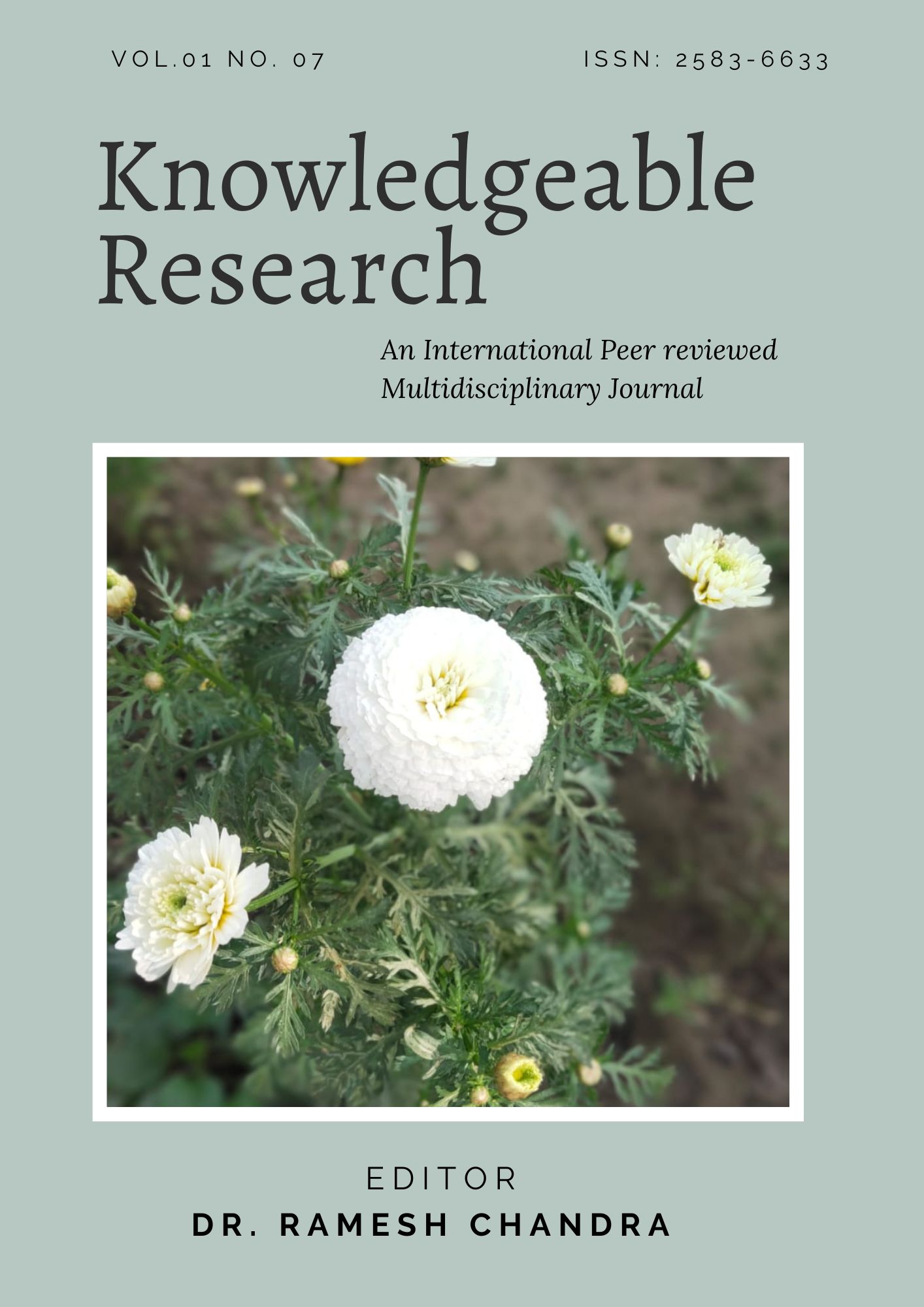Emerging Issues and Problems of Soil Salinity and Water Logging: A Case Study of Indira Gandhi Canal, Rajasthan
Main Article Content
Abstract
Soil salinity negatively affects plant growth and induces soil degradation. Saline soils indicate lower agricultural productivity and their impact on the livelihood security of farmers and the socio-economic status of the Indira Gandhi Canal region, Rajasthan. In the context of irrigation development, problems of rising groundwater levels and the development of salinity have arisen in the Indira Gandhi Nahar Priyojana (IGNP) area. The irrigation has recently decreased to about 1 meter, much higher than the specified value of 0.51 m in phase I. In phase I, severe inundation was observed. found in a variety of locations. It is anticipated that by the end of this century, roughly 49.6 percent of the region being studied will be at risk of experiencing flooding. The waterlogging, soil salinity, and alkalinity that plague India's agricultural landscape pose a challenge to the viability of irrigated farming. It has been determined that the most effective technique for halting the reduction in agricultural output is to use enhanced irrigation management in conjunction with a combination of surface and subsurface drainage. The method of reclaiming waterlogged lands by bio drainage is one that is efficient and economical. For the objectives of rehabilitation, species such as Salvador, Tamarix, Eucalyptus, and Prosopis Juliflora are among those that are recommended for planting in afflicted regions. The bio-drainage system helped in reducing the waterlogged areas and soil salinity by lowering the water table in the study area. Traditional knowledge and modern agricultural management good practices should be adopted for efficient and optimal use of water resources. This can be achieved by maintaining irrigation through the minimum pumping hours according to the minimum water requirements of the crop, as well as choosing more cost-effective planting methods. This research paper recommends policies to improve traditional and scientific knowledge into policies and improve mutual understanding, cooperation, and collaboration for better policy results for sustainable development and mitigate the emerging Issues and problems of soil Salinity and water logging in the area of Indira Gandhi Canal, Rajasthan.
Article Details
Section

This work is licensed under a Creative Commons Attribution-NonCommercial 4.0 International License.
How to Cite
References
Abrol, I.P., Yadav, J.S.P. and Massoud, F.I. (1988): Salt-Affected Soils and Their Management. FAO Soils Bull. 39. FAO, Rome.
Basic Statistics of Rajasthan (1988). Sri-Ganganagar, Hanumangarh, Bikaner & Jaisalmer Districts. Jaipur, India: Government of Rajasthan.
Basic Statistics of Rajasthan (1995). Sri-Ganganagar, Hanumangarh, Bikaner & Jaisalmer Districts. Jaipur, India: Government of Rajasthan.
Basic Statistics of Rajasthan (1996). Sri-Ganganagar, Hanumangarh, Bikaner & Jaisalmer Districts. Jaipur, India: Government of Rajasthan.
Basic Statistics of Rajasthan (2002). Sri-Ganganagar, Hanumangarh, Bikaner & Jaisalmer Districts. Jaipur, India: Government of Rajasthan.
Chatterji, P. C. and Saxena, S. K. (1988) Canal Irrigation in The Arid Zone of Rajasthan and Its Ecological Implications. In: Desert Ecology, 223-258.
Chouhan, T. S. (1988) Integrated Area Development of Indian Desert. Geo-environment Academia, Jodhpur, India.
Gerba, C. P., And Pepper, I. L. (2019). Municipal Wastewater Treatment. In Environmental and Pollution Science (Pp. 393-418). Academic Press.
Govt. Of Rajasthan, (1996). Indira Gandhi Canal Project; A Great Venture Of Miraculous Changes In Desert, IGNP Board, Bikaner, 10-11.
Govt. Of Rajasthan-` ‘Indira Gandhi Nahar Pariyojna, Annual Progress Report In Hindi’ Jaipur, 1990-94.
Hussain, A. (2019). Indira Gandhi Canal Project and Their Adverse Impact On The Environment of Western Rajasthan, IJHSSR, 5(1): 61-64.
ICAR (1992) Report of The Technical Group on The Problems of Seepage and Salinity In Indira Gandhi Nahar Pariyojana (IGNP).
Datta, K.K., Jongb, K.K., De, C., and Singha, O.P. (2000). Reclaiming Salt-Affected Land Through Drainage In Haryana, India: A Financial Analysis. Agricultural Water Management 46, Pp 55-71.
Kumar, N. (2017). Cause Of Water Logging and Salinity Problem of IGNP. International Research Journal of Commerce Arts and Science. Volume 8 Issue 12.
Kaur, G., Singh, G., Motavalli, P. P., Nelson, K. A., Orlowski, J. M., and Golden, B. R. (2020). Impacts And Management Strategies for Crop Production in Waterlogged or Flooded Soils: A Review. Agronomy Journal, 112(3), 1475-1501.
Kitamura, Y., Murashima, K. and Ogino, Y. (1997). "Drainage In Asia (II): Manifold Drainage Problems and Their Remedial Measures In India", Rural And Environment Engineering.
Kumar, M. D. (2001) "Market Instruments for Demand Management In The Face of Scarcity and Overuse of Water In Gujarat, Western India", Water Policy.
Raina, P., Kumar, M. & Singh, M. (2010). "Mapping Of Soil Degradation Hazards by Remote Sensing In Hanumangarh District (Western Rajasthan)", Journal Of The Indian Society Of Remote Sensing.
Maurya, A. (2017). Study of Waterlogging and Soil Salinization Problem In and Around Rawatsar Tehsil, Hanumangarh District In The Command Area Of Indira Gandhi Nahar Pariyojna (IGNP) Stage-I, Rajasthan, India. International Journal of Innovative Research And Advanced Studies (IJIRAS), Volume 4 Issue 4.
Prasad, A. S., Singh, A., Bandooni, S. K., and Negi, V. S. (2021). Water Resource Management Through Ecological Restoration in Garhwal Himalaya, Uttarakhand, India. In Water Science and Sustainability (pp. 157-167). Springer, Cham.
Pandey, B. W., And Anand, S. (2021). Sustainable Development Goal Series: Water Science And Sustainability: An Introduction. In Water Science And Sustainability (Pp. 5-12). Springer, Cham.
Rhoades, J.D. (1990): Soil Salinity – Causes and Control. In Techniques for Desert Reclamation. Wiley Publishers, New York, Pp. 109-134.
Sen, R. (1993). Afforestation In Indira Gandhi Nahar Pariyojana. A Dissertation Presented to University Of Rajasthan For The Degree of M.A., Pp.118.
Shahid, S. A., Zaman, M., & Heng, L. (2018). Introduction To Soil Salinity, Sodicity and Diagnostics Techniques. In Guideline for Salinity Assessment, Mitigation and Adaptation Using Nuclear And Related Techniques (Pp. 1-42). Springer, Cham.
Singh, A. (2021). Soil salinization management for sustainable development: A review. Journal of environmental management, 277, 111383.
Tewari, V. P.; Arrawatia, M. L. AND Kumar, V.S.K (1997). The problem of soil salinity and Waterlogging in Indira Gandhi Canal Area of Rajasthan State. Annals of Biology 13(1), 7-13.

